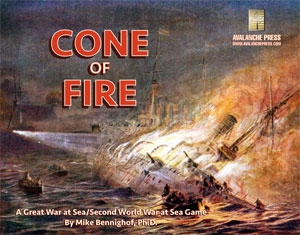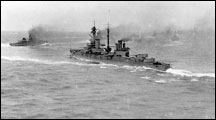| Cone of Fire:
The
Battleship Rio de Janeiro
By Mike Bennighof, Ph.D.
February 2018
 When Brazil accepted her
first two battleships, their builder,
Armstrong’s, had concerns that the Brazilians
might attempt to renege on their promise to
build a third one. The original contract had
been for three much smaller battleships, and
Armstrong’s had only agreed to alter
them on the slipways if Brazil signed guarantees
that all three would be constructed. When Brazil accepted her
first two battleships, their builder,
Armstrong’s, had concerns that the Brazilians
might attempt to renege on their promise to
build a third one. The original contract had
been for three much smaller battleships, and
Armstrong’s had only agreed to alter
them on the slipways if Brazil signed guarantees
that all three would be constructed.
The new ships brought Brazil the desired
international prestige and notoriety, but
volatile prices for her chief exports, coffee
and rubber, made it difficult to keep up payments.
The November 1910 mutinies aboard the first
two battleships, Minas Geraes and Sao
Paulo, put political pressure on the navy
to spend its funds on its sailors rather than
more warships. But even before those events,
many in Brazilian government circles wanted
to delete the third battleship from the naval
program.
As soon as Minas Geraes slid into
the water in September 1908, the British yard
began pressuring their customer to start a
new battleship on the same slipway. The Brazilians
had signed contracts promising to do just
that, but now wavered and asked for an indefinite
postponement. Armstrong’s instead offered
a one-year delay, and payments would now be
made in cash rather than Brazilian government
bonds. By 1910 the Brazilians felt able to
make their payments and directed that the
third sister, Rio de Janeiro, proceed.
In March the keel was laid, to the same design
as the first two battleships.

Under the White Ensign. HMS Agincourt,
the one-time Rio de Janeiro.
|
As with the stillborn pre-dreadnoughts ordered in 1904, Rio de Janeiro quickly
fell behind the Royal Navy’s latest
advances. In November 1909 the first “super
dreadnought armed with 13.5-inch guns, Orion, had been laid down at Portsmouth Dockyard,
the government facility that had built Dreadnought.
As with the earlier ship, Orion’s greater size and armament did not immediately
become obvious to the Brazilians. But in April
1910, Armstrong’s commenced construction
of her sister, Monarch, on the slipway
next to Rio de Janeiro. Brazilian visitors
quickly saw that their ship was noticeably
smaller and more lightly armed, and in May
the Brazilians ordered a halt to redesign
the ship.
Armstrong’s presented several alternatives,
and after some thought the Brazilians chose
an enlarged version of Minas Geraes mounting
twelve 14-inch guns in the same turret arrangement.
She had much improved armor protection, and
was faster than the earlier ships at 22 knots.
For several months the Brazilians dickered
over details, insisting on revisions of her
hammock stowage, searchlight suite and boat
arrangements. “Some suggestions,”
Armstrong’s chief negotiator, Tennyson
D’Eyncourt, reported back to his directors,
“had been too silly for words.”
Finally, in October 1910, the Brazilians
signed, but Armstrong’s had meanwhile
initiated a lockout of shipwrights and work
could not begin until late December. During
the delay, the naval mutiny had destroyed
Brazil’s will to build the ship and
led to the appointment of a new Navy Minister,
Admiral Margues Leao. The Brazilians had inserted
a clause requiring that a new minister had
to approve the design, and Leao was in no
hurry to do so. To protect his employer, D’Eyncourt
had countered with another clause that if
any alterations were made, the new ship had
to cost at least as much as the original order.
During a tour of European shipyards and naval
facilities, Leao had met the German Kaiser,
Wilhelm II, and described his new ship to
the emperor. Wilhelm, often dismissed as a
dilettante by popular historians, did possess
a fair amount of naval knowledge although
much of it was useless trivia. The supreme
warlord explained his navy’s conviction
that the 12-inch gun was perfectly adequate
to penetrate enemy armor and its higher rate
of fire and greater reliability more than
compensated for the bigger gun’s heavier
shell weight. This fit with the views of many
in the Brazilian navy, who questioned the
need for a larger caliber. Leao now asked
for fresh designs reverting to the 12-inch
gun.
The shipyard presented several revised versions
of Minas Geraes, reducing the main
armament from a dozen 12-inch guns to ten,
but giving the same broadside thanks to better
layout. Anticipating more Brazilian wavering,
they also put forward designs with 16-inch
guns in case their clients once again tried
to shock the world. D’Eyncourt traveled
to Rio de Janeiro and found Leao “much
more sensible” than his predecessor,
but when he invoked the clause requiring the
Brazilians to spend at least as much as they
had for Minas Geraes, Leao balked at
spending more money for a ship that on paper
appeared to be less powerful than the previous
ships. The Brazilians had committed themselves
to 12-inch guns, yet the ship mounting them
had to be more powerful than Minas Geraes.
Armstrong’s duly presented a design
for a ship with fourteen heavy guns. The Brazilians
signed in June 1911 and Rio de Janeiro was laid down for the fourth time in September.
 
Buyer’s remorse set in almost immediately.
Brazilian newspapers questioned the purchase
of the new ship when the Americans were building
powerful battleships for Argentina with 14-inch
guns, and Chile was building her own pair
at Armstrong’s 14-inch guns as well
(and as an added insult, with the very same barrels
ordered for the 14-inch-gun version of Rio
de Janeiro).
After months of grumbling, in September 1913,
the Brazilians directed Rothschild’s,
their financial agent in the warship purchases,
to dispose of the ship. In a final effort
to salvage the contract, Armstrong’s
presented a revised design replacing the seven
double turrets bearing 12-inch guns with single
turrets each mounting a 15-inch gun. Royal
Navy tests had shown that a single mount had
a rate of fire about 20 percent greater than
that of a double mount, and so the new arrangement
would offer about the same firepower as Britain’s
new Queen Elizabeth class.
The Brazilian decision touched off a frenzy
among potential buyers: Despite her somewhat
obsolete armament, a dreadnought of any type
that could be completed quickly had great
value to nations engaged in their own arms
races. Turkey eventually won the bidding war, slipping her offer
past France and Greece with the aid of a friendly
French banker. Freed of her obligation and
holding 1.2 million sterling from the Turks,
Brazil now began shopping for a replacement.
But that’s a completely different story.
Rio de Janeiro appears in Cone
of Fire in both her 12-inch and 15-inch
guises. She’s appeared in numerous Great
War at Sea games.
Order
Cone
of Fire now!
Mike Bennighof is president of Avalanche Press and holds a doctorate in history from Emory University. A Fulbright Scholar and award-winning journalist, he has published over 100 books, games and articles on historical subjects.
He lives in Birmingham, Alabama with his wife, three children and his dog, Leopold.
|
